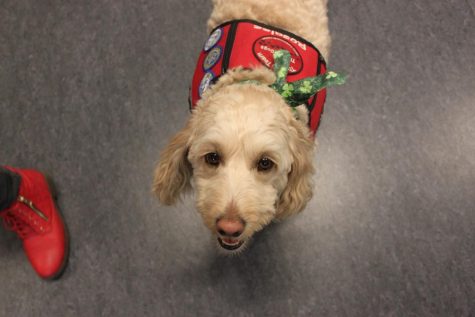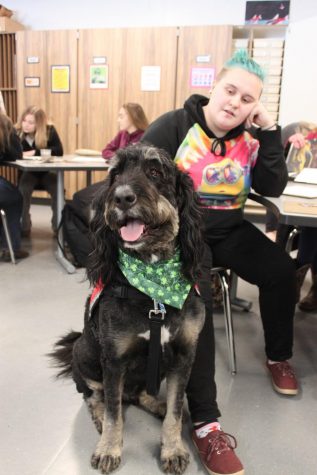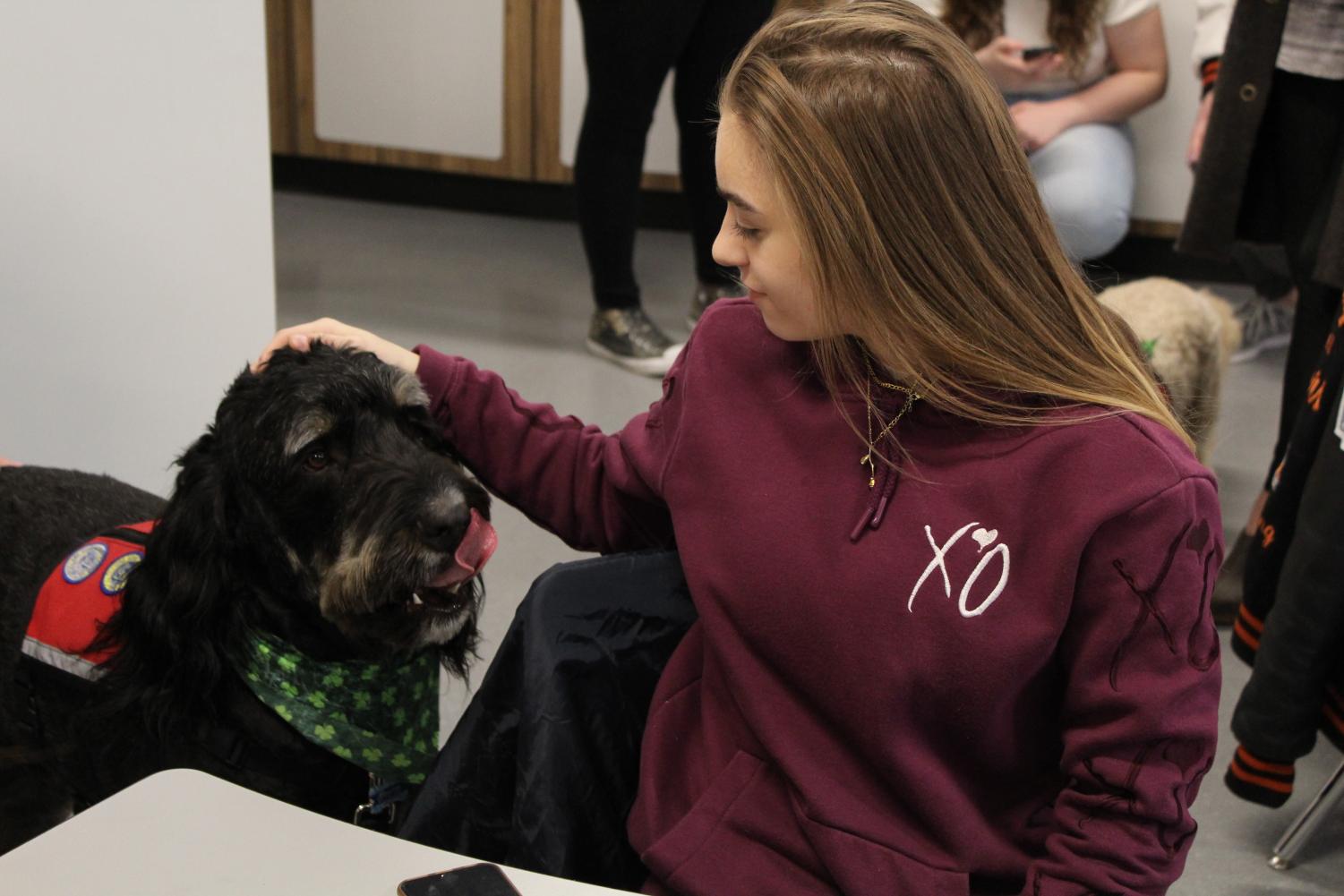Working against stress, one belly rub at a time
High school works with Pinckney-located GO TEAM therapy dogs
April 13, 2018
As Monroe and Rosalee walk into English teacher Pam Gower’s room, the gasps and smiles emit from the room, drowning out the worries of tests or assignments that are approaching.
Gower’s students smile ear to ear, all very excited to introduce themselves to Monroe and Rosalee. These two are new and already popular, and they do not even talk.
Monroe and Rosalee are not students━they are GO TEAM therapy dogs.
Their handlers, Bonnie and Paul Barbick have been members of GO TEAM for over a year; however, GO TEAM has been around for a lot longer.
Starting in 2012 in Waldo Canyon in Colorado, after a wildfire destroyed 347 homes and more than 32,000 people were evacuated, GO TEAM got its start. Two dogs along with their handlers went to hotels to help soothe the devastated residents and to destress the first responders.
GO TEAM then felt that their services were needed across the nation. Over 800 dog and handler teams are members of GO TEAM, and their program has grown worldwide.
Becoming a member of GO TEAM is a long process and involves months of training. The dogs must be at least one year of age before they can begin. The process starts with passing a CGC test, or Canine Good Citizen, through the AKC (American Kennel Club). There are full weekends dedicated to multiple scenarios training including nursing homes, TSA at an airport, elevators, escalators and even fire trucks with lights on and sirens blaring.
“We walked down Michigan Avenue for one of the trainings. We went to Bass Pro Shop, so there is lots of people everywhere,” handler Bonnie said. “We just walk around and they’re quite comfortable doing that.”

Rosalee, a 3-year-old Miniature English Golden Doodle, looks up at the camera and gives her best smile. When not on duty, Rosalee enjoys swimming, traveling and belly rubs.
When Rosalee and Monroe are on the job, they cannot eat, play nor eliminate (what humans call “using the bathroom”). They only drink water.
Getting the dogs to the school happened at a chance meeting.
English teacher Elizabeth Cyr felt there was a need for these dogs in school after she had seen them in the hospital while with her mother.
“My mother suffered a traumatic head injury, so I was at the hospital quite often,” she said. “It was stressful, and sometimes sad, and the dogs always provided temporary relief.”
Cyr began to notice that she wasn’t alone in this feeling and she described what she called the “serendipity moment” when she realized she may be able to bring this same sort of relief to her students.
“I saw the instant joy the dogs brought to people,” she said, “and the after effects it carried.”
Cyr said she saw a lot of tension and stress at the school that wasn’t normally there. She then began to think that the dogs could be a solution.
“I asked Bonnie if she came to schools, and we started coming up with a plan,” she said.
Barbick, who is certified with both Monroe and Rosalee, glows with passion when it comes to helping people.
“I love the smile on people’s faces, the joy that you see when they pet our dogs, when they just see us walk in. I had a lady say to me, she was just observing, and she said, ‘You made that lady so happy!’”
— Handler Bonnie Barbick
“I love the smile on people’s faces, the joy that you see when they pet our dogs, when they just see us walk in,” Barbick said. “I had a lady say to me, she was just observing, and she said, ‘You made that lady so happy!’”
Senior Elizabeth Salyer experienced a visit from the therapy dogs during her first block in Jen Leuneberg’s class, and just loves dogs.
When Salyer saw them, it happened to be the anniversary of the death of former student, Sevila Nash.
“This is a bad day for some of us, and [the dogs] came in the door, and we just started crying because we were so happy,” Salyer said. “Seeing the dogs just brought our mood up.”
These dogs not only have benefits for mental health, but also could have positive effects on physical health. According to UCLA Health, petting a therapy dog helps lower blood pressure and slow down breathing in people who are anxious. Petting a therapy dog also releases serotonin, a neurotransmitter that helps lower depression. Dogs can help promote physical healing also, according to Therapy Dogs United.

Though his fourth birthday was just celebrated this last January, Monroe has been training to be a GO TEAM therapy dog since he was a puppy. When this Bernedoodle is not working with children and adults, Monroe enjoys hiking, playing fetch and snuggling.
Barbick thinks her volunteer work is helpful and enjoys every second of working at the high school.
“Working at Stockbridge has been delightful! The happiness and joy I see on so many faces while we are visiting, there are no words for that,” she said. “I hear laughter and such happy sounds while we are with the students. I’ve heard students say, ‘This is the best day ever.’
I can not get enough of that!”
Barbick first started working with therapy dogs when she got Monroe.
“I’ve always wanted to have a therapy dog for some reason,” she said.
She learned about the GO TEAM through Sit Means Sit training, who is partnered with them.
“[GO TEAM] just sounded so amazing and so awesome, that we went and did our good Canine Good Citizen test,” Barbick said. “I was a nervous wreck. It was just a CGC test and I thought I was taking the biggest exam of my life, and [Rosalee] passed it with flying colors.”
But now, Barbick knows her job not only helps others, but also her too.
“I walk out of these places, anywhere I go, and I wonder who got the most therapy,” she said.
“The guests, the staff, or me?”

